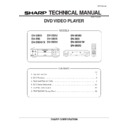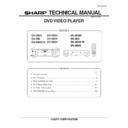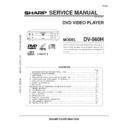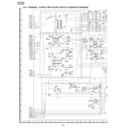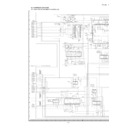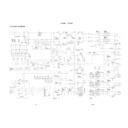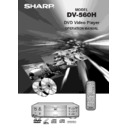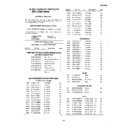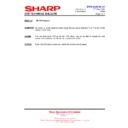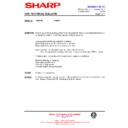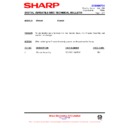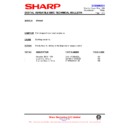Sharp DV-560H (serv.man6) Service Manual ▷ View online
4
DVD-Series
1-3 Disc Structure
The first layer on the 2-layers disc (semitransparent reflection film) does not reflect unless the laser
light is focused.
light is focused.
(1) 1 layer on both sides
(2) 2 layers on 1 sides
1-4 Disc Capacity
1 layer on 1 side
2 layers on 1 side
1 layer on both sides
2 layers on both sides
12cm
4.7
8.5
9.4
17
8cm
1.4
2.6
2.9
5.3
1-5 Example of the DVD’s calculating memory capacity Condition
Condition
1. More than 3.5Mbps of average image data rate
(The compression rate changes depending on the image. This is the average value)
2. Audio is Dolby AC-3, 5.1ch digital sound
3. Dubbed in 3 languages + subtitled in 4 languages
4. 133 minutes are recorded on a 1 layer on 1 side disc
3. Dubbed in 3 languages + subtitled in 4 languages
4. 133 minutes are recorded on a 1 layer on 1 side disc
Required data rate
Image
Audio
Subtitles
Total
3,500k
+
(384k
×
3)
+
(10k)
=
4,692kbps(bit/second)
Required disc capacity
Data Rate
Recording Duration
Memory Capacity
4, 692kbps
×
(133
×
60) second
÷
8 (8bit = 1byte)
=
4.680.270kBytes
4.7 gigabytes are required to record 133 minutes on a 1 layer on 1 side disc
Type of Disc
Disc Size
,,,,,,,,,,,
,,,,,,,,,,,
0.6mm
0.6mm
Side B
(Standard reflection film)
(Standard reflection film)
Adhesive layer
Side A
(Standard reflection film)
(Standard reflection film)
,,,,,,,,,,,
,,,,,,,,,,,
0.6mm
0.6mm
Second layer
(Standard reflection film)
(Standard reflection film)
Adhesive layer
(transparent)
(transparent)
First layer
(semitransparent reflection film)
(semitransparent reflection film)
5
DVD-Series
1-6 Order and Direction of Disc Recording
There are 3 types of recording orders and directions.
1 layer disc
2 layers disc (B)
1-7 Two Discs are Stacked Together to Form DVD discs
The DVD disc structure is the stacking of two 0.6mm thin type discs, making it most suitable for
reading high density recorded data signals.
The thinner the disc, the less number of obstacles between pits notched on the optical pick up and
disc, so more precise reading can be achieved.
Additionally, stacking these same material discs together back-to-back, increases evenness,
meaning the disc will warp less due to heat and humidity compared to single 1.2mm boards. Thus,
the discs are more reliable.
reading high density recorded data signals.
The thinner the disc, the less number of obstacles between pits notched on the optical pick up and
disc, so more precise reading can be achieved.
Additionally, stacking these same material discs together back-to-back, increases evenness,
meaning the disc will warp less due to heat and humidity compared to single 1.2mm boards. Thus,
the discs are more reliable.
Features of the 0.6mm Thick Disc
1. Materialized mass capacity and high density
• Because the thickness is half that of traditional discs, it is less likely to warp or slant.
• Degree of evenness becomes much higher at assembly, with high rates of evenness and
• Degree of evenness becomes much higher at assembly, with high rates of evenness and
precision.
2. Makes board-making easier and reduces production costs
• The stacked structure is highly resistant to environmental changes (heat, humidity)
• The thin structure increases the time cycle, so forming is easier stabilized
• Overall, it will cost less than 20% more than a CD.
• The thin structure increases the time cycle, so forming is easier stabilized
• Overall, it will cost less than 20% more than a CD.
2 layers disc (A)
,,
,,
,,,,
,,,,
2
1
Data area
Lead-in area
Lead-out area
Parallel track path
Center of the disc
,,
,,
Center of the disc
Lead-in area
Data area
Lead-out area
,,
,,,
2
1
Data area
Lead-in area
Lead-out area
Middle area
Opposite track path
Center of the disc
0.6mm
0.6mm
1.2mm
Changes in temperature and humidity
DVD (stacked-together structure)
CD (single board structure)
6
DVD-Series
2. DVD Features
2-1 DVD is not a Digital Video Disc
“DVD” is often considereed the abbreviation for Digital Video Disc, but as the unified standard
for the next generation of high density optical fiber discs, the term “DVD” is not used in that way.
It has been adopted as the name of the unified standard.
for the next generation of high density optical fiber discs, the term “DVD” is not used in that way.
It has been adopted as the name of the unified standard.
2-2 Amazing Mega-Capacity
Although the DVD’s size is the same as a 12cm CD, one DVD side can record huge capacity, about
4.7GB, equivalent to approximately 7 CDs. This disc can be recorded to 133 minutes for full a
movie film, with high quality picture and sound which like a movie theater.
Additionally, it is only the capacity for one side. The 1 side 2 layer type can record 8.5GB, the 2
sides with 1 layer type can record 9.4 GB and an amazing maximum 17GB can be recorded on 2
side 2 layers type.
4.7GB, equivalent to approximately 7 CDs. This disc can be recorded to 133 minutes for full a
movie film, with high quality picture and sound which like a movie theater.
Additionally, it is only the capacity for one side. The 1 side 2 layer type can record 8.5GB, the 2
sides with 1 layer type can record 9.4 GB and an amazing maximum 17GB can be recorded on 2
side 2 layers type.
4.7
GB
=
688
MB
●
Comparison of DVD data capacity
DVD
(one side)
CD
X 6.8 CDs
7 times as more
than a CD
DVD
(one side)
CD
2.2 (side)
2.2 times as much a
s an LD
133
MIN
=
60
MIN
●
Comparison of DVD recording times (approximate)
The memory capacity of a disc is determined by the time of information and amount of data per
second (data rate). In the case of CDs, the number of quantization bits is 16, and the sampling
wavelength is 44.1kHz with 2 channels. So, the amount of data is 16
second (data rate). In the case of CDs, the number of quantization bits is 16, and the sampling
wavelength is 44.1kHz with 2 channels. So, the amount of data is 16
×
44.1k
×
2 = approx.1,411k
bits/second = 1.411M bits/second.
The maximum length of a CD is 74 minutes. If the same sound from a CD is recorded on the DVD,
it comes to 4.7GB. That means, 37.6 (4.7
The maximum length of a CD is 74 minutes. If the same sound from a CD is recorded on the DVD,
it comes to 4.7GB. That means, 37.6 (4.7
×
8), and it will come to 37.6
×
1,000
÷
1.411 = approx.
26,648 (seconds) for one side.
That is approximately 444 minutes (7 hours 24 minutes).
That is approximately 444 minutes (7 hours 24 minutes).
2-3 Secrets of Producing Large Capacity Recording and Long Hour Replay
1. Realization of large capacity recording
The track pitch is less than half of that of a CD, making it longer.
Also, the recorded amount of information is increased due to the smaller pit (less than half of
that of a CD)
Because the pit is smaller, the laser focus needs to be smaller. To do this, the wavelength of the
laser beam is shortened and the opening of the object lens (NA) is increased.
This bigger NA increases the influence of the aberration of laser beam from the protection film
(the transparent plastic part). This causes blurring of the laser focus against the disc inclination,
or its slippage when the pit becomes bigger, lowering the signal reading precision (increasing
noise).
To decrease the influence of this laser beam aberration from protection film (transparent plastic
part), we decreased the thickness of the disc.
(one-half that of a CD, 0.6mm) Also ensure CD compatibility, we put 2 of the discs together.
By putting 2 of these 0.6mm thick discs together, the evenness of the disc is increased, warping
due to heat and humidity is decreased and the signal reading precision is improved.2.
Also, the recorded amount of information is increased due to the smaller pit (less than half of
that of a CD)
Because the pit is smaller, the laser focus needs to be smaller. To do this, the wavelength of the
laser beam is shortened and the opening of the object lens (NA) is increased.
This bigger NA increases the influence of the aberration of laser beam from the protection film
(the transparent plastic part). This causes blurring of the laser focus against the disc inclination,
or its slippage when the pit becomes bigger, lowering the signal reading precision (increasing
noise).
To decrease the influence of this laser beam aberration from protection film (transparent plastic
part), we decreased the thickness of the disc.
(one-half that of a CD, 0.6mm) Also ensure CD compatibility, we put 2 of the discs together.
By putting 2 of these 0.6mm thick discs together, the evenness of the disc is increased, warping
due to heat and humidity is decreased and the signal reading precision is improved.2.
7
DVD-Series
λ
2. Comparison of CDs and DVDs
Item
CD
DVD
DVD(CD)
Track Pitch
1.60
µ
m
0.74
µ
m
1.60
µ
m
Minimum Pit
0.87
µ
m
0.40
µ
m
0.87
µ
m
Laser Beam Wavelength
780nm
(Infrared Light)
650nm
(Red)
650nm
(Red)
Opening of the Object Lens
0.45
0.6
0.38
Laser Focus
1.8
µ
m
1.0
µ
m
1.7
µ
m
*CD mode of DVD
3. Decreasing the Laser Beam Focus Wavelength
The size of the laser beam focus
Φ
has small
λ
, When NA increases, it becomes smaller.
It is determined using the following formul:
NA (Opening of the object lens) = DVD : 0.6
CD(DVD) : 0.38
Φ
=
NA
λ
(laser beam wavelength) = 650nm
DVD
Φ
=
0.6
= about 1
µ
m
CD(DVD)
Φ =
0.38
= about 1.7
µ
m
NA shows the brightness of the lens. When the focal distance of the lens becomes shorter and
the diameter increases, the NA becomes bigger. It is determined using the following formul:
the diameter increases, the NA becomes bigger. It is determined using the following formul:
4. Longer Track, Smaller Pit
650nm
650nm
NA =
f
a
a
Disk
f
Laser Beam Focus
0.74 Track Width
Minimum Pit
0.4

